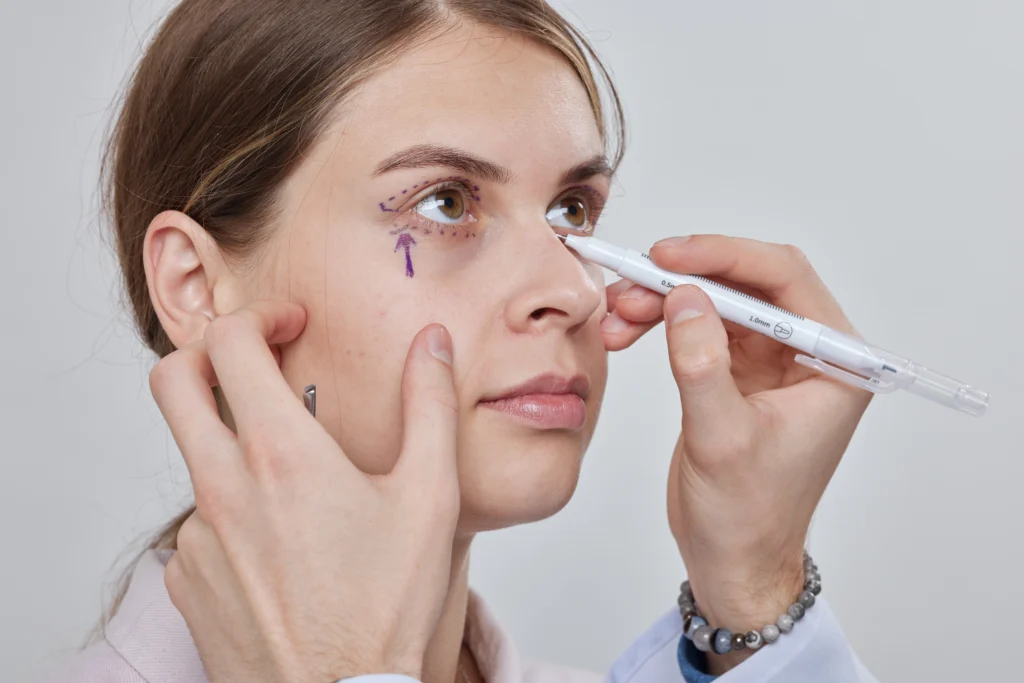Upper vs. Lower Blepharoplasty: Which One Do You Need?

Table of contents
1.
Key Differences Between Upper and Lower Eyelid Surgery
2.
5.
6.
7.
8.
If you’re wondering about the difference between upper vs lower blepharoplasty, the answer is simple: upper blepharoplasty targets excess skin and drooping of the upper eyelids, while lower blepharoplasty focuses on under-eye bags and puffiness beneath the eyes. Both are highly effective, addressing distinct cosmetic and functional concerns around the eyes. Understanding these differences can help you decide which option—or combination—is suited to your needs.
When comparing upper and lower blepharoplasty, the most important distinctions are what each procedure treats:
Upper Blepharoplasty removes or repositions excess upper eyelid skin and fat, correcting hooded or sagging eyelids.
Lower Blepharoplasty targets puffiness, under-eye bags, and fine wrinkles below the lower eyelids.
Both procedures can rejuvenate your appearance, but they serve different purposes. Some patients benefit from one or the other, while others choose to combine both for comprehensive eye area rejuvenation.
Upper eyelid surgery, or upper blepharoplasty, is a cosmetic procedure designed to address sagging, drooping, or excess skin on the upper eyelids. This surgery is especially popular among individuals who notice a “tired” or “heavy” appearance in their eyes, or in cases where loose skin impairs their vision.
Benefits of upper blepharoplasty include:
Brighter, more open-looking eyes
Improved peripheral vision after removing sagging skin
Smoother eyelid contours
Reduced heaviness or tired appearance
Most patients notice a refreshed, natural look after healing, with results that can last for many years.
Lower eyelid surgery, also known as lower blepharoplasty, is designed to treat puffiness, bags, or wrinkles that appear beneath the eyes. This procedure is ideal for individuals with under-eye circles, persistent swelling, or sagging skin below the eyes that contributes to a fatigued look.
Key benefits of lower blepharoplasty:
Reduction or elimination of under-eye bags
Smoother, firmer skin beneath the eyes
Less visible dark circles (when caused by shadowing from puffiness)
A more rested, youthful look
Patients often report a dramatic improvement in their self-confidence and overall facial appearance.
Combining upper and lower blepharoplasty procedures can be an effective solution for individuals dealing with both drooping skin on the upper lids and puffy under-eye bags. By addressing these concerns together, a surgeon can remove or reposition excess fat and tighten the delicate skin around the eyes, resulting in a more balanced and youthful appearance. Whether you’re struggling with issues related to the upper lids, lower lids, or both, a combined approach may offer the most comprehensive results. Depending on your specific needs and the extent of correction required, the procedure can be performed under local or general anesthesia to ensure comfort and safety throughout.
Recovery after upper vs lower blepharoplasty is generally straightforward, but knowing what to expect can help you plan for a smooth healing process.
Typical recovery tips include:
Rest and Elevate: Keep your head elevated and rest as much as possible for the first few days.
Cold Compresses: Applying cold compresses can help minimize swelling and bruising.
Avoid Straining: Refrain from heavy lifting, strenuous exercise, and bending over for at least a week.
Follow Post-Op Instructions: Carefully adhere to all aftercare guidelines provided by Dr. Ann Jayaram, including medication use and wound care.
Most swelling and bruising subside within 10–14 days, with final results becoming apparent over several weeks. Many patients return to work and social activities within 7–10 days, depending on the extent of their procedures. Complete recovery may take up to a year.
Deciding between upper vs lower blepharoplasty—or a combination of both—depends on your unique anatomy, goals, and concerns.
Consider the following questions:
Do you have excess skin or drooping of the upper eyelids?
Are you bothered by puffiness, bags, or sagging below your eyes?
Is your vision affected by heavy upper eyelids?
Are you seeking a more comprehensive rejuvenation of the eye area?
During your consultation with Dr. Ann Jayaram, your facial structure, skin quality, and aesthetic goals will be thoroughly evaluated to help determine the most effective approach. In some cases, combining both procedures delivers the most harmonious and youthful results.
If you’re interested in complementing eyelid surgery with non-surgical options, treatments such as fillers or brow lamination may further enhance your look.
Dr. Ann Jayaram is a board-certified facial plastic surgeon with a deep focus on procedures involving the upper or lower eyelids. Known throughout the Bay Area as an eyelid specialist, she brings unmatched precision to every case, whether treating drooping eyelids or removing fatty or excess skin that contributes to a tired look.
With over 7,000 eyelid and ocular procedures performed, Dr. Jayaram combines her advanced training in oculoplastic surgery with an artistic eye for detail—helping patients achieve a naturally youthful appearance that complements their unique features. Her approach to cosmetic surgery is rooted in compassion, technical expertise, and a clear understanding of how the aging process affects the delicate eye area. Whether you’re seeking treatment for functional concerns or aesthetic refinement, Dr. Jayaram offers exceptional care in a comfortable setting.
Eyelid surgery is one of the most commonly performed cosmetic procedures. When it comes to upper and lower blepharoplasty, the right choice depends on whether your primary concern is excess skin and sagging above the eyes, under-eye bags and puffiness, or a combination of both. Both procedures can deliver subtle, natural rejuvenation, helping you look as refreshed as you feel. Consulting an experienced oculoplastic surgeon, such as Dr. Ann Jayaram, is the best way to create a personalized plan tailored to your facial features and goals.